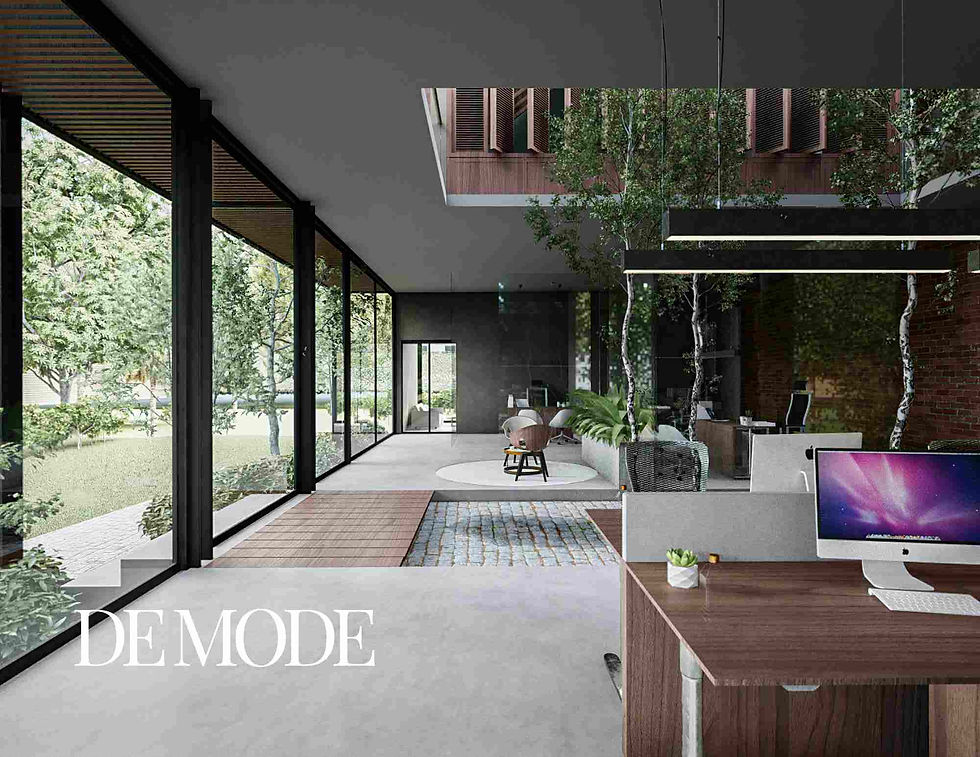"BIOPHILIC DESIGN - INTEGRATING NATURE INTO ARCHITECTURE": DE MODE GLOBAL
- DE MODE

- Jun 24, 2024
- 4 min read
ORIGINALLY PUBLISHED IN DE MODE | ARCHITECTURE
Article Published on: 24TH JUNE 2024 | www.demodemagazine.com
Biophilic design is a concept gaining significant traction in architecture and urban planning, centered around integrating natural elements and processes into the built environment. It stems from the innate human connection with nature and aims to create environments that support both physical and mental well-being. This design approach goes beyond mere aesthetics; it seeks to improve our overall quality of life by fostering a harmonious relationship between humans and nature within the spaces we inhabit.
At its core, biophilic design recognizes that as a species, humans have evolved in close connection with the natural world. Our physiological and psychological health is deeply influenced by exposure to natural light, vegetation, natural materials, and the sights, sounds, and smells of nature. However, as urbanization intensifies and modern lifestyles increasingly detach us from the natural environment, biophilic design offers a way to reintegrate these essential elements back into our daily lives.

Principles of Biophilic Design
1. Visual Connection with Nature
Visual access to nature can be achieved through large windows, views of greenery, water features, or nature-inspired art. This principle acknowledges the calming effect of natural scenes and helps reduce stress while promoting a sense of well-being.
2. Natural Light and Ventilation
Maximizing natural light not only reduces energy consumption but also enhances the mood and productivity of occupants. Proper ventilation, incorporating natural airflow patterns, can improve air quality and create a more comfortable indoor environment.
3. Biomorphic Forms and Patterns
Incorporating natural shapes, curves, and patterns into architectural elements and interior design can evoke a sense of comfort and familiarity, contributing to a more relaxing and inviting atmosphere.
4. Natural Materials and Textures
Using materials such as wood, stone, bamboo, and natural fabrics not only connects us visually to nature but also brings in tactile experiences that stimulate our senses and create a soothing environment.
5. Living Systems and Greenery
Integrating living plants, green walls, or rooftop gardens not only improves air quality by filtering pollutants but also enhances the aesthetics of a space and provides opportunities for interaction with nature.
6. Sensory Stimuli
Incorporating natural sounds like flowing water or birdsong, as well as natural scents such as essential oils or plant aromas, can create a multisensory experience that mimics being outdoors, promoting relaxation and reducing stress.
7. Cultural and Biophilic Diversity
Acknowledging and incorporating elements of local biodiversity, cultural practices, and traditions related to nature can deepen the connection between people and their environment, fostering a sense of place and identity.

Applications of Biophilic Design in Architecture
Biophilic design principles are applicable across various types of architecture, from residential buildings to commercial spaces, educational institutions, healthcare facilities, and urban planning initiatives. For example, in residential architecture, incorporating large windows that frame views of natural landscapes, using natural materials like wood for flooring and furniture, and creating indoor gardens or green spaces can transform a home into a sanctuary that promotes relaxation and well-being.
In workplaces, biophilic design can enhance productivity and creativity by providing employees with access to natural light, greenery, and spaces for relaxation or collaboration that mimic natural settings. Educational institutions can benefit from biophilic design by creating learning environments that inspire curiosity and focus while reducing stress among students and teachers alike.
Healthcare settings often incorporate biophilic elements to promote healing and recovery, with features such as healing gardens, natural light in patient rooms, and artwork inspired by nature helping to create a more comforting and supportive environment for patients and caregivers.
Benefits of Biophilic Design
The benefits of biophilic design are manifold and extend beyond mere aesthetics:
Improved Well-being: Studies have shown that exposure to nature and natural elements can reduce stress, lower blood pressure, and improve overall mental health and well-being.
Enhanced Productivity and Creativity: In work and educational environments, biophilic design has been linked to increased productivity, creativity, and concentration levels among occupants.
Sustainable Practices: By promoting natural ventilation, maximizing daylighting, and incorporating sustainable materials, biophilic design supports environmentally friendly building practices and reduces energy consumption.
Community and Social Benefits: Creating spaces that foster a connection to nature can strengthen community ties, encourage outdoor activities, and promote a sense of stewardship for the natural environment.
Challenges and Considerations
Implementing biophilic design principles may pose challenges such as cost implications, especially when integrating complex natural systems or materials. There may also be limitations in urban settings where space is limited or where existing infrastructure does not easily accommodate green features. However, innovative approaches and technologies are continuously being developed to overcome these challenges, making biophilic design more accessible and feasible for a wide range of projects.

Conclusion
In conclusion, biophilic design represents a holistic approach to architecture and urban planning that prioritizes the well-being of inhabitants by reconnecting them with nature. By integrating natural elements and processes into the built environment, biophilic design not only enhances the aesthetic appeal of spaces but also promotes physical health, mental well-being, and environmental sustainability. As cities continue to grow and evolve, embracing biophilic design principles offers a path towards creating healthier, more resilient, and more enjoyable places to live, work, and play.



Comments